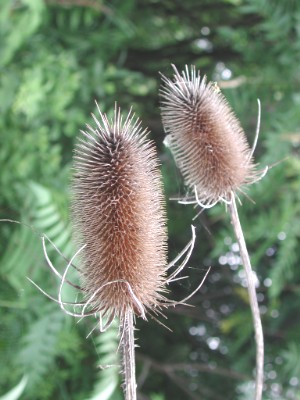Dipsacaceae on:
[Wikipedia]
[Google]
[Amazon]
 The Dipsacaceae were recognized as a family (the teasel family) of the order Dipsacales containing 350 species of perennial or biennial
The Dipsacaceae were recognized as a family (the teasel family) of the order Dipsacales containing 350 species of perennial or biennial
Dipsacaceae of Mongolia in FloraGREIF
Historically recognized angiosperm families Dipsacales {{Dipsacales-stub
herb
Herbs are a widely distributed and widespread group of plants, excluding vegetables, with savory or aromatic properties that are used for flavoring and garnishing food, for medicinal purposes, or for fragrances. Culinary use typically distingu ...
s and shrub
A shrub or bush is a small to medium-sized perennial woody plant. Unlike herbaceous plants, shrubs have persistent woody stems above the ground. Shrubs can be either deciduous or evergreen. They are distinguished from trees by their multiple ...
s in eleven genera. It was published by Antoine Laurent de Jussieu
Antoine Laurent de Jussieu (; 12 April 1748 – 17 September 1836) was a French botanist, notable as the first to publish a natural classification of flowering plants; much of his system remains in use today. His classification was based on an e ...
in his book ''Genera plantarum'' on page 194 in 1789.
The family is now regarded as a synonym of the family Caprifoliaceae
The Caprifoliaceae or honeysuckle family is a clade of dicotyledonous flowering plants consisting of about 860 species in 33 to 42 genera, with a nearly cosmopolitan distribution. Centres of diversity are found in eastern North America and easte ...
. Native to most temperate climates, they are found in Europe
Europe is a continent located entirely in the Northern Hemisphere and mostly in the Eastern Hemisphere. It is bordered by the Arctic Ocean to the north, the Atlantic Ocean to the west, the Mediterranean Sea to the south, and Asia to the east ...
, Asia
Asia ( , ) is the largest continent in the world by both land area and population. It covers an area of more than 44 million square kilometres, about 30% of Earth's total land area and 8% of Earth's total surface area. The continent, which ...
, and Africa
Africa is the world's second-largest and second-most populous continent after Asia. At about 30.3 million km2 (11.7 million square miles) including adjacent islands, it covers 20% of Earth's land area and 6% of its total surfac ...
. Some species of this family have been naturalized in other places. The spikes of the common teasel (pictured) are not particularly spiny and may be quite soft. In some places, the spikes were used in carding
In Textile manufacturing, textile production, carding is a mechanical process that disentangles, cleans and intermixes fibres to produce a continuous web or sliver (textiles), sliver suitable for subsequent processing. This is achieved by passi ...
wool.
The family has contained these genera;
*'' Acanthocalyx''
*'' Dipsacus'' (teasel
''Dipsacus'' is a genus of flowering plant in the family Caprifoliaceae. The members of this genus are known as teasel, teazel or teazle. The genus includes about 15 species of tall herbaceous biennial plants (rarely short-lived perennial plants ...
)
*'' Knautia''
*''Scabiosa
''Scabiosa'' is a genus in the honeysuckle family (Caprifoliaceae) of flowering plants. Many of the species in this genus have common names that include the word scabious, but some plants commonly known as scabious are currently classified in re ...
''
*'' Succisa'' (devil's bit)
*'' Succisella''
*'' Morina''—also placed in its own family, Morinaceae
*'' Cephalaria''
*'' Pterocephalus''
*'' Pycnocomon''
*'' Triplostegia''
References
External links
Dipsacaceae of Mongolia in FloraGREIF
Historically recognized angiosperm families Dipsacales {{Dipsacales-stub